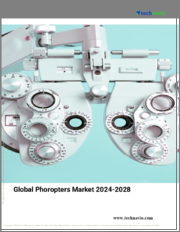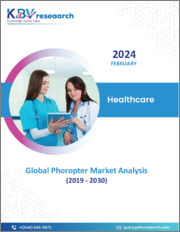
|
시장보고서
상품코드
1485276
포롭터 시장 : 제품 유형별, 최종 용도별 - 세계 예측(2024-2032년)Phoropter Market - By Product Type (Manual, Automated), End-use (Hospitals, Specialty Clinics, Optical Shops) - Global Forecast 2024 - 2032 |
||||||
포롭터 시장 규모는 2024년부터 2032년까지 CAGR 4.5%로 확대될 것으로 예측됩니다.
근시, 원시, 난시 등 시력 장애의 유병률 증가로 인해 종합적인 안과 검사에 대한 수요가 증가하고 있으며, 정확한 처방을 결정하는 데 있어 정확한 처방을 결정하는 데 있어 포롭터가 중요한 역할을 하고 있습니다. 이처럼 눈과 관련된 장애로 인한 부담이 증가함에 따라, 포롭터에 대한 수요도 증가하고 있습니다.
디지털화 및 전자 의료 기록(EHR) 시스템과의 통합 등 굴절 검사의 효율성과 정확성을 향상시켜 안과 의료 전문가들 사이에서 채택을 더욱 촉진하는 등, 포롭터 기술이 크게 발전하고 있습니다. 정기적인 안과 검진의 중요성에 대한 인식이 높아지고 노인 인구가 증가함에 따라, 안과 검진에 대한 인식이 높아짐에 따라, 안과 검진에 대한 검진 횟수가 증가하고 있습니다. 의료 인프라의 확대와 일차 의료에 안과 의료 서비스의 통합은 업계 성장을 더욱 촉진할 것으로 보입니다.
포롭터 시장은 제품 유형, 최종 용도 및 지역별로 분류됩니다.
제품 유형별로 보면 수동식은 자동식에 비해 신뢰성이 높고 가격이 저렴해 2024년부터 2032년까지 4.8%의 성장률로 시장 규모가 확대될 것으로 추정됩니다. 조작이 간편하고 안과 의료진에게 친숙하다는 점이 제품의 지속적인 사용에 기여하고 있습니다. 또한, 수동식 포롭터는 렌즈 조정을 정확하게 제어할 수 있기 때문에 정확한 처방 결정을 보장하기 위한 특수 검사에 적합합니다.
병원에서 종합적인 안과 의료 서비스에 대한 수요가 증가함에 따라, 병원 최종 용도 분야의 포롭터 산업은 2032년까지 4.4%의 CAGR로 확대될 것으로 예상됩니다. 병원은 다양한 안과 질환을 진단하고 치료하는 주요 센터로 기능하고 있으며, 이에 따라 포롭터와 같은 첨단 진단 장비가 필요합니다. 안과 의료 서비스가 종합병원으로 통합되고 환자 수가 증가함에 따라 이 부문의 성장도 촉진될 것으로 보입니다.
아시아태평양에서는 라이프스타일의 변화와 스크린 사용 시간의 증가로 인해 시력 장애의 유병률이 증가함에 따라 2032년까지 5.1%의 CAGR을 기록할 것으로 예측됩니다. 특히 중국과 인도와 같은 신흥국에서는 의료 인프라가 확대되고 안과 의료 서비스 및 포롭터와 같은 진단 장비에 대한 접근성이 향상되고 있습니다. 가처분 소득의 증가와 정기적인 안과 검진의 중요성에 대한 인식이 높아짐에 따라 이 지역의 산업이 강화될 것으로 보입니다.
목차
제1장 조사 방법과 조사 범위
제2장 주요 요약
제3장 업계 인사이트
- 생태계 분석
- 업계에 대한 영향요인
- 성장 촉진요인
- 안질환 유병률 증가
- 포롭터 기술 진보
- 안과 검사 수요 증가
- 콘택트렌즈와 안경 보급 확대
- 업계의 잠재적 리스크와 과제
- 숙련된 전문가의 부족
- 장비와 관련된 고비용
- 성장 촉진요인
- 성장 가능성 분석
- 규제 상황
- 기술 상황
- Porters 분석
- PESTEL 분석
- 향후 시장 동향
제4장 경쟁 상황
- 소개
- 기업 매트릭스 분석
- 기업 점유율 분석
- 경쟁 포지셔닝 매트릭스
제5장 시장 추정과 예측 : 제품 유형별, 2018-2032년
- 주요 동향
- 수동
- 자동
제6장 시장 추정과 예측 : 최종사용자별, 2018-2032년
- 주요 동향
- 병원
- 전문 클리닉
- 안경점
- 기타 최종사용자
제7장 시장 추정과 예측 : 지역별, 2018-2032년
- 주요 동향
- 북미
- 미국
- 캐나다
- 유럽
- 독일
- 영국
- 프랑스
- 스페인
- 이탈리아
- 기타 유럽
- 아시아태평양
- 일본
- 중국
- 인도
- 호주
- 한국
- 기타 아시아태평양
- 라틴아메리카
- 브라질
- 멕시코
- 아르헨티나
- 기타 라틴아메리카
- 중동 및 아프리카
- 사우디아라비아
- 남아프리카공화국
- 아랍에미리트
- 기타 중동 및 아프리카
제8장 기업 개요
- Carl Zeiss Meditec AG
- Huvitz Corp
- Marco
- NIDEK CO., LTD
- Reichert, Inc.
- Rexxam Co, Ltd.
- Topcon Corporation
- US Ophthalmic
- Visionix
- Xenon Ophthalmics Inc.
Phoropter Market size is projected to expand at 4.5% CAGR from 2024 to 2032. The increasing prevalence of vision disorders, such as myopia, hyperopia, and astigmatism is fueling the demand for comprehensive eye examinations, where phoropters play a crucial role in determining accurate prescriptions. According to CDC, approximately 12 million people aged 40 years and above in the U.S. have vision impairment. This increasing burden of eye related disorders is driving the demand for phoropters.
Significant advancements in phoropter technology, like digitalization and integration with electronic health records (EHR) systems are enhancing efficiency and accuracy in refraction tests, further favoring adoption among eye care professionals. The rising awareness of the importance of regular eye check-ups and the growing elderly population are increasing the volume of eye examinations conducted using phoropters. The expansion of healthcare infrastructure and the integration of eye care services into primary care settings will further compliment the industry growth.
The phoropter market is segregated into product type, end-use, and region.
Based on product type, the market value from the manual segment is estimated to rise at 4.8% growth rate from 2024 to 2032, on account of the reliability and affordability of manual phoropters compared to automated alternatives. The simplicity of operation and familiarity among eye care professionals is contributing to the continued product use. Manual phoropters also offer precise control over lens adjustments, making them suitable for specialized examinations for ensuring accurate prescription determination.
Phoropter industry from the hospitals end-use segment will expand at 4.4% CAGR until 2032, owing to the increasing demand for comprehensive eye care services within these settings. Hospitals serve as primary centers for diagnosing and treating various eye conditions, thus requiring advanced diagnostic equipment like phoropters. The integration of eye care services into multispecialty hospitals and the rising patient volume will also boost the segment growth.
Regionally, the Asia Pacific phoropter market is projected to witness 5.1% CAGR until 2032, due to the rising prevalence of vision disorders owing to lifestyle changes and increasing screen time. The expanding healthcare infrastructure, especially in emerging economies like China and India is enhancing accessibility to eye care services and diagnostic equipment like phoropters. The growing disposable incomes and rising awareness about the importance of regular eye check-ups will bolster the regional industry.
Table of Contents
Chapter 1 Methodology & Scope
- 1.1 Market scope & definition
- 1.2 Base estimates & calculations
- 1.3 Data collection
- 1.4 Forecast parameters
- 1.5 Data sources
- 1.5.1 Primary
- 1.5.2 Secondary
- 1.5.2.1 Paid sources
- 1.5.2.2 Public sources
Chapter 2 Executive Summary
- 2.1 Industry 360 degree synopsis
Chapter 3 Industry Insights
- 3.1 Industry ecosystem analysis
- 3.2 Industry impact forces
- 3.2.1 Growth drivers
- 3.2.1.1 Increasing prevalence of eye disorder
- 3.2.1.2 Rising advancements in phoropter technology
- 3.2.1.3 Rising demand for eye examinations
- 3.2.1.4 Growing adoption of contact lenses and eyeglasses
- 3.2.2 Industry pitfalls & challenges
- 3.2.2.1 Lack of skilled professionals
- 3.2.2.2 High cost associated with the equipment
- 3.2.1 Growth drivers
- 3.3 Growth potential analysis
- 3.4 Regulatory landscape
- 3.5 Technological landscape
- 3.6 Porter's analysis
- 3.6.1 Supplier power
- 3.6.2 Buyer power
- 3.6.3 Threat of new entrants
- 3.6.4 Threat of substitutes
- 3.6.5 Industry rivalry
- 3.7 PESTEL analysis
- 3.8 Future market trends
Chapter 4 Competitive Landscape, 2023
- 4.1 Introduction
- 4.2 Company matrix analysis
- 4.3 Company market share analysis
- 4.4 Competitive positioning matrix
Chapter 5 Market Estimates and Forecast, By Product Type, 2018 - 2032 ($ Mn)
- 5.1 Key trends
- 5.2 Manual
- 5.3 Automated
Chapter 6 Market Estimates and Forecast, By End-Use, 2018 - 2032 ($ Mn)
- 6.1 Key trends
- 6.2 Hospitals
- 6.3 Specialty clinics
- 6.4 Optical shops
- 6.5 Other end-users
Chapter 7 Market Estimates and Forecast, By Region, 2018 - 2032 ($ Mn)
- 7.1 Key trends
- 7.2 North America
- 7.2.1 U.S.
- 7.2.2 Canada
- 7.3 Europe
- 7.3.1 Germany
- 7.3.2 UK
- 7.3.3 France
- 7.3.4 Spain
- 7.3.5 Italy
- 7.3.6 Rest of Europe
- 7.4 Asia Pacific
- 7.4.1 Japan
- 7.4.2 China
- 7.4.3 India
- 7.4.4 Australia
- 7.4.5 South Korea
- 7.4.6 Rest of Asia Pacific
- 7.5 Latin America
- 7.5.1 Brazil
- 7.5.2 Mexico
- 7.5.3 Argentina
- 7.5.4 Rest of Latin America
- 7.6 Middle East and Africa
- 7.6.1 Saudi Arabia
- 7.6.2 South Africa
- 7.6.3 UAE
- 7.6.4 Rest of Middle East and Africa
Chapter 8 Company Profiles
- 8.1 Carl Zeiss Meditec AG
- 8.2 Huvitz Corp
- 8.3 Marco
- 8.4 NIDEK CO., LTD
- 8.5 Reichert, Inc.
- 8.6 Rexxam Co, Ltd.
- 8.7 Topcon Corporation
- 8.8 US Ophthalmic
- 8.9 Visionix
- 8.10 Xenon Ophthalmics Inc.















